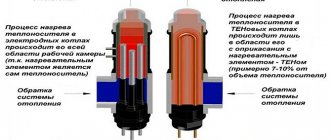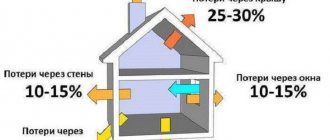If a meter is not installed in the house, then when determining the amount of fuel consumed, the rate of gas consumption per person per month is taken into account. This indicator is set by government agencies based on the location of the region, the purpose of fuel use and other criteria.
It is generally accepted that a person consumes on average about 10 cubic meters. meters of gas per month. To set the exact figure you need a counter. Installing meters allows you to save money, since a person only pays for what his family has used.
Is it necessary to install a meter in an apartment?
In the past, the law required installing a gas meter in the apartment. But recently it has become irrelevant. Those who use gas exclusively for cooking were exempted from the obligation to install meters.
The law states that if gas consumption is no more than 2.1 cubic meters per hour, installation of the device is not required.
Note!
Installation of a gas meter depends on the desires and capabilities of the owner.
Manufacturers produce several types of meters:
- rotary;
- membrane;
- electronic;
- volumetric.
Rotary: do not make noise, are checked every five years, are relatively inexpensive.
Membrane: a simple device, reliable, affordable, but they have some disadvantages - they make a lot of noise, are large, and require frequent checking.
Electronic: small size, high accuracy, silent, checked once every ten years. Quite expensive.
Volumetric: high-quality and inexpensive. Check once every ten years. Among the disadvantages, consumers note loud noise and large dimensions.
To make your choice, you need to consider important points:
- price;
- required level of noise emitted;
- device size;
- mounting location;
- required inspection frequency.
Note!
Gas meters can be installed both indoors and outdoors.
Many types of devices can withstand temperatures from low to high.
Here are some tips for choosing: if your apartment or house has a gas water heater or stove, then a rotary or electronic meter is better suited. If the house also has a gas boiler, then a volumetric or membrane meter is suitable. According to consumer market data, the most inexpensive device costs about 1,100 rubles. To mount the controller on two devices: a gas flow-through heater and a stove, the meter will cost approximately three thousand rubles. No installation fee.
Note!
In some cases, installation requires replacement of pipes or parts thereof at the location where the device is mounted. Also, before starting installation of the controller, a mounting diagram is drawn up.
An electronic meter is ideal for indoor installation. Most consumers choose it for its small size and noise level.
If you have a gas boiler and stove, it is better to choose a meter with a capacity of up to twenty-five cubic meters of gas per hour. If the stove only runs on gas, then a capacity of more than five cubic meters is not needed.
Note!
The installation of gas meters should only be carried out by workers with special education.
Vehicle fuel consumption standards from the Ministry of Transport for 2022
To calculate certain costs associated with the purchase and use of fuel, there must be reasoned economic and financial recommendations that allow you to write off gasoline, diesel or liquefied gas. First of all, this applies to enterprises and sectors of the national economy that use vehicles of various types and modifications in their activities. But so that the numbers in the accounting books do not appear out of the blue, the Ministry of Transport of the Russian Federation establishes the necessary fuel consumption standards for cars.
Fuel consumption standards take into account both its type (gasoline, diesel, gas) and quantity for use. Accountants and economists, not drivers, keep records of spent and saved fuel in order to avoid possible fraud. The standards recommended by the order of the Ministry of Transport help organizations and vehicle fleets:
- maintain reports;
- determine the cost of transporting goods or passengers;
- conduct settlements with employees using cars or buses for official purposes;
- From these norms, the total tax amount of the enterprise is determined.
The basic consumption rates of any fuel are a value that reflects the average consumption of gasoline, diesel or gas by a particular model of car per hundred kilometers of distance traveled. At the same time, it is important to remember that the Russian Ministry of Transport considers fuel consumption standards solely taking into account the movement of vehicles on smooth, straight highways, which in practice is not always confirmed due to the occurrence of emergency situations. The basic standards do not take into account the fuel consumption of vehicles with the engine running during technical work in a garage or parking lot.
To calculate the standard amount of fuel consumption, the order of the Ministry of Transport provides a special consumption formula. When compiling it, we took into account the type of transport, its individual technical parameters, type of fuel, route conditions, weight and method of movement. Also, to calculate the fuel consumption rate, the weight of transported goods (for trucks) or the number of passengers (for buses) is taken into account. Gasoline, diesel fuel and liquefied gas are measured in liters, while regular gas is measured in cubic meters. The formula looks like this:
0.01 * Hs * S * (1 + D * 0.01), where:
Hs is the fuel consumption rate provided for in the technical characteristics of the vehicle; S – number of kilometers traveled; D – correction factor.
Since emergency situations arise quite often during the operation of vehicles, correction factors have to be included in the documentation. The latest version of the Ministry of Transport resolution on fuel consumption, which is also valid in 2022, states that a 10% surcharge is applied to vehicles undergoing run-in. When the air conditioner is running, about 7% is added to the estimated consumption. Up to 10% of fuel is added to trucks, and up to 35% when transporting large cargo. In winter, the correction factor ranges from 5 to 20%. For new vehicles (with a service life of no more than 5 years) 5% is added, for old vehicles (as well as with a mileage of more than 100 thousand kilometers) - 10%. When using cars on roads with poor surfaces, 30% is added to the basic consumption rate, and if the road runs along a mountain serpentine, then 20%.
Gas consumption standards per person without a meter.
According to the standards, about 11 cubic meters of gas are required per person per month, with centralized heating and hot water supply. One cubic meter of gas costs about 5 rubles 10 kopecks. The total for the month is 55 rubles. In the absence of a metering device, for a family of three people it turned out to be 165 rubles.
Note!
Based on research results, it is known that the average family consumes no more than 4 cubic meters of gas per month. The calculation turns out to be about 57 rubles per month.
You also need to take into account that when installing new water heating devices, the installation of meters is mandatory.
Fuel consumption rate GAZ Sobol. Gazelle next
Buses and all-metal vans, due to their increased weight, consume 13-14 liters on the highway, and modifications with all-wheel drive burn up to 16.5 liters on the highway. A decent selection of components, equipment for installing gas cylinders, as well as the cylinders themselves of all sizes and types at a price affordable for most users.
| GAS NEXT | Fuel consumption, l/100 km |
| GAZ NEXT Chassis | 8,5 |
| GAZ NEXT onboard platform | 8,5 |
| GAZ NEXT europlatform | 8,7 |
| GAZ NEXT “Farmer” Europlatform | 8,9 |
| GAZ NEXT all-metal van | 13,5 |
| GAZ NEXT “Farmer” flatbed with awning, 7 seats. | 10,3 |
| GAZ NEXT “Farmer” manufactured goods van | 10,7 |
| GAZ NEXT “Farmer” isothermal van | 10,5 |
| GAZ NEXT “Farmer” refrigerator (sandwich) | 11,2 |
| GAZ NEXT refrigerator (sandwich) | 11,4 |
Pros and cons of installing a gas meter.
As in any other situation, installing this device has its advantages and disadvantages. The advantages include:
- saving gas in summer by using a gas water heater;
- payment only for those cubic meters that were used.
Among the disadvantages, consumers note the following factors: the high cost of gas meters, regular state verification of the device once a year costs about 350 rubles, and with a large family it is not possible to save.
Note!
Gas consumption metering devices are suitable for families with one to three people living in them. Only then will savings take place. If there are 3-5 residents in an apartment with a gas meter, you will have to overpay.
How else can you save money?
How else can you save money?
Gas stove
Place dishes (kettle, pots, pans) on a suitable size burner. If the burner is larger, you heat the air unnecessarily. If it is less, the bottom heats up unevenly. Cover the dishes with a lid - this reduces heat loss by about 20%.
Heat the contents of the cookware to the desired temperature as quickly as possible. But after boiling, it is better to reduce the gas - the fire should not lick the walls of the pan. Don't burn gas in vain - for example, don't let water boil away in a kettle.
It is best to use energy-efficient stainless steel cookware with a polished bottom and a copper or aluminum layer. True, it costs more than usual. And throw away dishes with a deformed bottom - they waste one and a half times more gas.
An electric kettle, a coffee maker instead of a cezve, a microwave, a multicooker - all these appliances save gas (although they increase electricity costs).
Are gas meters profitable?
If there is only one stove in the house that runs on gas, the device will help save money. Let's consider an option where the apartment has a gas stove, the same water heater and five residents. The price of one cubic meter of gas varies slightly depending on the region. In the Moscow region - 4.40 rubles. And for one person, according to the standards, 24 cubic meters of gas per month. Simple mathematical operations help to calculate the amount per person: 105.60 rubles. Next: 105.60 multiplied by 5 (number of residents) = 528 rubles.
The standards can be looked at on the rent receipt and calculated.
Provided that the installation of the meter is approximately two thousand rubles, and the device itself costs a little more than 2 thousand, the cost of its installation is about four thousand rubles. This is with one gas stove.
At the same time, if a family of one or two people has only a gas stove installed, then you won’t be able to save much.
It’s more difficult for those who have both a stove and a gas water heater. Connecting a meter will cost 5-7 thousand rubles. Consumption standards in this case will be higher. And installing a metering device is a significantly labor-intensive task. In some cases, the installation of two meters is required.
To find out more precisely, you should contact the gas service. An on-site specialist will carry out calculations and explain all the details.
Since gas tariffs increase every year, there is nothing wrong with an apartment owner wanting to save on utility bills. Moreover, the Russian Government adopted Federal Law No. 261 “On Energy Saving...”.
The only exception is considered to be emergency housing that is undergoing demolition and consumes less than 2.1 cubic meters of gas per hour.
Regarding the question: are gas meters profitable, consumer opinions vary. Many people believe that installation is too expensive, will not pay off soon, and does not make sense. Because the devices themselves quickly fail or start spinning very quickly for no apparent reason. Repairs take up to three months, and they are not always repairable.
Note!
If an elderly person lives alone in an apartment and pays 60 rubles according to the standard for 12 cubic meters of gas per month, then installing an appliance costing eight thousand rubles will pay for itself in 10 years.
But, if a family of five people living in a private house has a gas water heater and a gas boiler installed, according to the standards for such a family, the amount is prohibitive. In this case, installing a gas meter will be a salvation for the family budget.
Debt
Many consumers do not pay utility bills. Changes in gas prices have no effect on the debt problem. Experts say that some categories of citizens refuse to pay for gas not because of rising fuel prices, but because of personal convictions.
The authorities regularly introduce various programs to encourage the population to pay for utilities. Regarding gas supply, consumers are required to pay their bills every month by the 10th of the month. If a citizen stops making payments, he will be fined. The amount of collections is 17.7% of the annual debt.
We recommend reading: Is it possible to get away with just a fine for non-payment and for unauthorized connection to gas
The debtor begins to be fined after three months of non-payment. The state provides penalties for companies that provide public services. If such companies use low-quality fuel or supply gas irregularly, they must pay 1/170 of the refinancing.
And if there is a meter, the tariffs will not increase?
The government has decided not to increase housing and communal services tariffs from January 1, 2017. That is, the cost of 1 cubic meter. m of hot water or 1 kW of electricity will remain the same as in 2016.
But from July 1, tariffs will increase. The subjects decide how much the housing and communal services fees will increase. The government has established average tariff increase indices from July 1. For example, in the Astrakhan region, utilities will rise in price by an average of 4.4%. In the Irkutsk region - by 5%, in Moscow - by 7%, and in St. Petersburg - by 6%.











